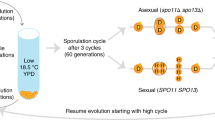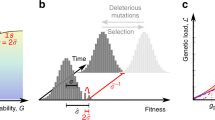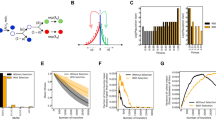Abstract
Identifying the forces responsible for the origin and maintenance of sexuality remains one of the greatest unsolved problems in biology1,2,3,4,5,6. The mutational deterministic hypothesis postulates that sex is an adaptation that allows deleterious mutations to be purged from the genome; it requires synergistic interactions, which means that two mutations would be more harmful together than expected from their separate effects4,5. We generated 225 genotypes of Escherichia coli carrying one, two or three successive mutations and measured their fitness relative to an unmutated competitor. The relationship between mutation number and average fitness is nearly log-linear. We also constructed 27 recombinant genotypes having pairs of mutations whose separate and combined effects on fitness were determined. Several pairs exhibit significant interactions for fitness, but they are antagonistic as often as they are synergistic. These results do not support the mutational deterministic hypothesis for the evolution of sex.
This is a preview of subscription content, access via your institution
Access options
Subscribe to this journal
Receive 51 print issues and online access
$199.00 per year
only $3.90 per issue
Buy this article
- Purchase on Springer Link
- Instant access to full article PDF
Prices may be subject to local taxes which are calculated during checkout



Similar content being viewed by others
References
Williams, G. C. Sex and Evolution(Princeton Univ. Press, Princeton, (1975)).
Maynard Smith, J. The Evolution of Sex(Cambridge Univ. Press, Cambridge, MA, (1978)).
Bell, G. The Masterpiece of Nature(Univ. California Press, Berkeley, (1982)).
Kondrashov, A. S. Deleterious mutations and the evolution of sexual reproduction. Nature 336, 435–440 (1988).
Kondrashov, A. S. Classification of hypotheses on the advantage of amphimixis. J. Hered. 84, 372–387 (1993).
Hurst, L. D. & Peck, J. R. Recent advances in understanding of the evolution and maintenance of sex. Trends Ecol. Evol. 11, 46–52 (1996).
Muller, H. J. The relation of recombination to mutational advantage. Mut. Res. 1, 2–9 (1964).
Haigh, J. The accumulation of deleterious genes in a population: Muller's ratchet. Theor. Popul. Biol. 14, 251–267 (1978).
Kimura, M. & Maruyama, T. The mutational load with epistatic gene interactions in fitness. Genetics 54, 1337–1351 (1966).
Crow, J. F. in Genetic Loads and the Cost of Natural Selection(ed. Kojima, K. I.) 128–177 (Springer, New York, (1970)).
Redfield, R. J., Schrag, M. R. & Dean, A. M. The evolution of bacterial transformation: sex with poor relations. Genetics 146, 27–38 (1997).
Spassky, B., Dobzhansky, Th. & Anderson, W. W. Genetics of natural populations. XXXVI. Epistatic interactions of the components of the genetic load in Drosophila pseudoobscura . Genetics 52, 653–664 (1965).
Kitigawa, O. Interactions in fitness between lethal genes in heterozygous condition in Drosophila melanogaster . Genetics 57, 809–820 (1969).
Mukai, T. The genetic structure of natural populations of Drosophila melanogaster . VII. Synergistic interaction of spontaneous mutant polygenes controlling viability. Genetics 61, 749–761 (1969).
Chao, L. Evolution of sex in RNA viruses. J. Theor. Biol. 133, 99–112 (1988).
De Visser, J. A. G. M., Hoekstra, R. F. & van den Ende, H. The effect of sex and deleterious mutations on fitness in Chlamydomonas . Proc. R. Soc. Lond. B 263, 193–200 (1996).
De Visser, J. A. G. M., Hoekstra, R. F. & van den Ende, H. Test of interaction between genetic markers that affect fitness in Aspergillus niger . Evolution(in the press).
Willis, J. H. Effects of different levels of inbreeding on fitness components in Mimulus guttatus . Evolution 47, 864–876 (1993).
Zeyl, C. & Bell, G. The advantage of sex in evolving yeast populations. Nature 388, 465–468 (1997).
Lenski, R. E. & Travisano, M. Dynamics of adaptation and diversification: a 10,000-generation experiment with bacterial populations. Proc. Natl Acad. Sci. USA 91, 6808–6814 (1994).
Kleckner, N., Bender, J. & Gottesman, S. Uses of transposons with emphasis on Tn 10 . Methods Enzymol. 204, 139–181 (1991).
Sokal, R. R. & Rohlf, F. J. Biometry(Freeman, New York, (1981)).
Sniegowski, P. D., Gerrish, P. J. & Lenski, R. E. Evolution of high mutation rates in experimental populations of Escherichia coli . Nature 387, 703–705 (1997).
Charlesworth, B. Mutation-selection balance and the evolutionary advantage of sex and recombination. Genet. Res. 55, 199–221 (1990).
Kibota, T. T. & Lynch, M. Estimate of the genomic mutation rate deleterious to overall fitness in E. coli . Nature 381, 694–696 (1996).
Otto, S. P. & Feldman, M. W. Deleterious mutations, variable epistatic interactions, and the evolution of recombination. Theor. Popul. Biol. 51, 134–147 (1997).
Rice, W. R. Analyzing tables of statistical tests. Evolution 43, 223–225 (1989).
Elena, S. F., Ekunwe, L., Hajela, N., Oden, S. A. & Lenski, R. E. Distribution of fitness effects caused by random insertion mutations in Escherichia coli . Genetica(in the press).
Lenski, R. E., Rose, M. R., Simpson, S. C. & Tadler, S. C. Long-term experimental evolution in Escherichia coli . I. Adaptation and divergence during 2,000 generations. Am. Nat. 138, 1315–1341 (1991).
Zyskind, J. W. & Bernstein, S. I. Recombinant DNA Laboratory Manual(Academic, San Diego, (1989)).
Acknowledgements
We thank V. de Lorenzo, L. Forney, J. Peck and O. Schabenberger for advice and encouragement; L. Ekunwe and N. Hajela for technical support; and A. de Visser, J. Mongold, P.Moore, S.Otto, B. Rice, D. Rozen and C. Zeyl for valuable comments. This work was supported by a fellowship from the Spanish MEC to S.F.E. and a grant from the NSF to R.E.L.
Author information
Authors and Affiliations
Corresponding author
Rights and permissions
About this article
Cite this article
Elena, S., Lenski, R. Test of synergistic interactions among deleterious mutations in bacteria. Nature 390, 395–398 (1997). https://doi.org/10.1038/37108
Received:
Accepted:
Issue Date:
DOI: https://doi.org/10.1038/37108
This article is cited by
-
The origination events of gametic sexual reproduction and anisogamy
Journal of Ethology (2022)
-
Moderate Amounts of Epistasis are Not Evolutionarily Stable in Small Populations
Journal of Molecular Evolution (2020)
-
The causes of evolvability and their evolution
Nature Reviews Genetics (2019)
-
Mutation bias and GC content shape antimutator invasions
Nature Communications (2019)
-
Environmental fluctuations accelerate molecular evolution of thermal tolerance in a marine diatom
Nature Communications (2018)
Comments
By submitting a comment you agree to abide by our Terms and Community Guidelines. If you find something abusive or that does not comply with our terms or guidelines please flag it as inappropriate.



